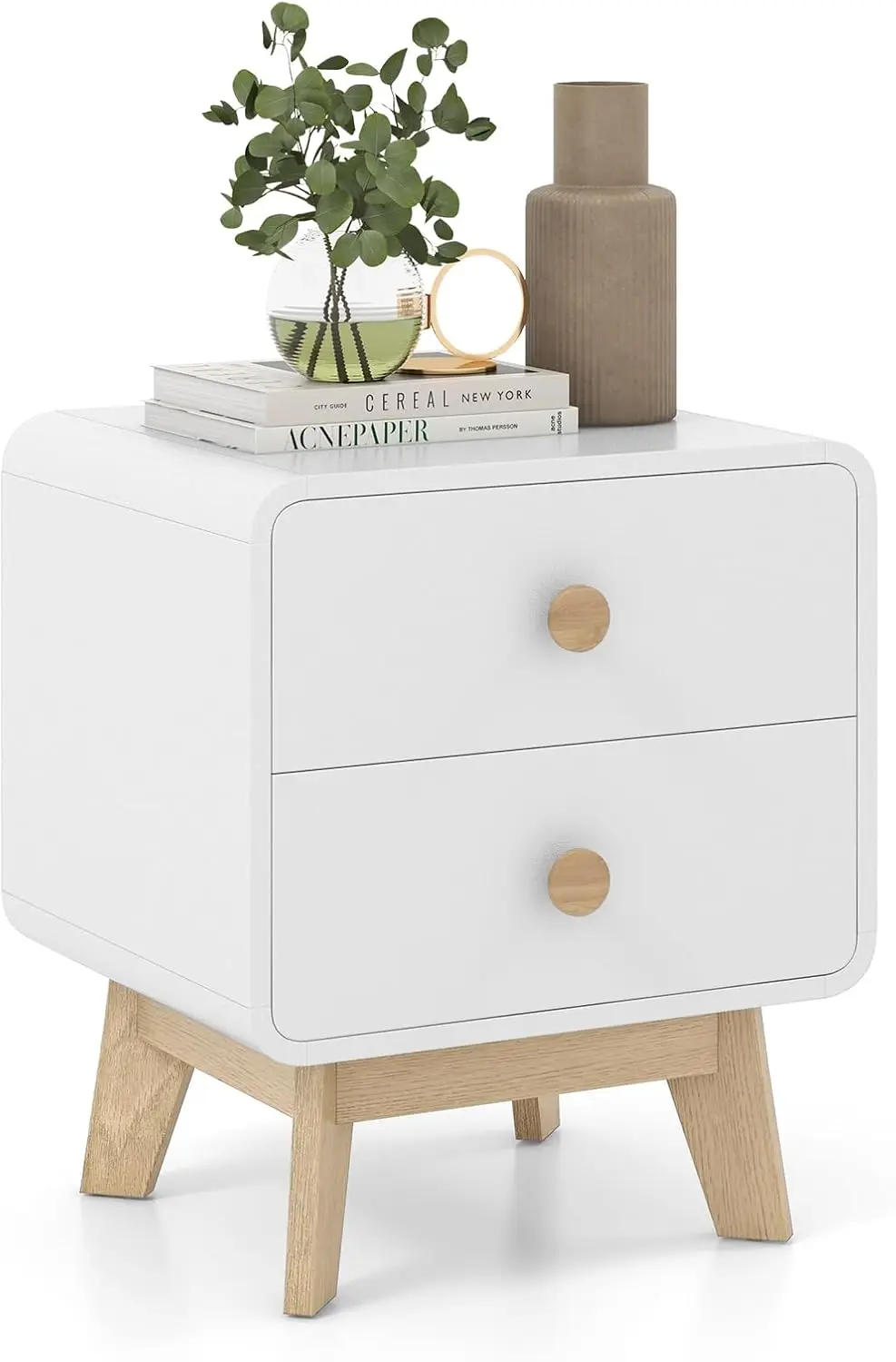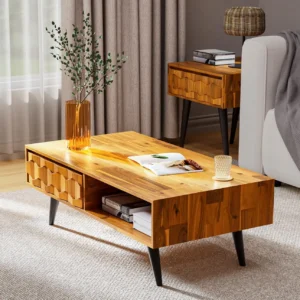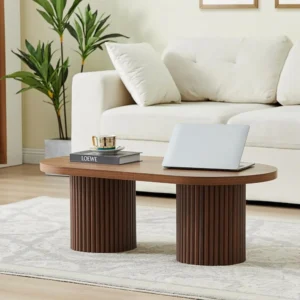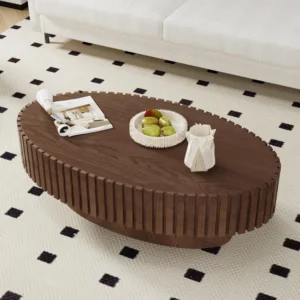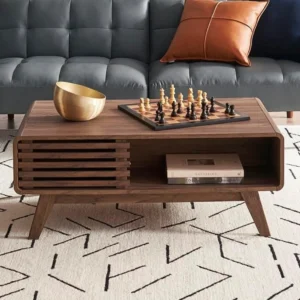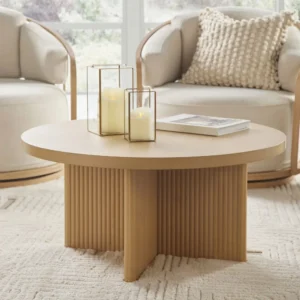Introduction: The Significance of Understanding Furniture Craftsmanship
When we talk about vintage furniture, we’re referring to pieces that are typically between 30 and 100 years old—not quite antique but carrying the distinctive design elements and construction techniques of their era. Understanding the craftsmanship behind these pieces does more than satisfy curiosity; it provides a foundation for making informed decisions when collecting, purchasing, or appraising furniture.
The relationship between quality construction and longevity is undeniable. While mass-produced modern furniture often lasts just a few years, well-crafted vintage pieces can remain functional and beautiful for generations. This durability stems directly from superior construction methods, material selection, and attention to detail.
For collectors and enthusiasts alike, the ability to recognize authentic craftsmanship unlocks a deeper appreciation of intelligent black mid-century coffee tables and other vintage pieces. This knowledge helps distinguish genuine articles from reproductions and determines appropriate value—whether monetary, historical, or aesthetic.
Throughout this guide, we’ll explore the key elements that reveal true craftsmanship: joinery techniques, material quality, hardware authenticity, and construction methods. These indicators tell the story of how furniture was made across different periods, from Victorian elegance to the clean lines of black mid-century modern coffee table styles and beyond.
The Telltale Signs of Superior Joinery
Joinery—how wooden components connect to create a unified piece—stands as perhaps the most definitive indicator of furniture craftsmanship. These connections determine not just how a piece looks, but how well it will hold up over decades of use.
Distinguished Joint Types and Their Significance
Dovetail Joints: These interlocking, trapezoidal-shaped joints are hallmarks of quality craftsmanship, particularly in drawer construction. Hand-cut dovetails feature slightly irregular spacing and width, with thin pins and wider tails. Machine-cut dovetails, more common after 1890, display perfectly uniform spacing and identical dimensions—still quality indicators, but less valued than their handmade counterparts.
Mortise and Tenon Joints: Often found where table legs meet aprons or in chair frames, these joints feature a projecting tenon that fits precisely into a mortise (cavity). When examining furniture, look for tight fits and strategic placement at stress points.
Finger Joints: These box-like interlocking joints appear similar to dovetails but have rectangular projections. Though less strong than dovetails, their presence still indicates quality construction.
Knapp Joints: Also called “pin and cove” or “blip” joints, these round-ended connections were used primarily between 1870-1900. Their presence helps date furniture to this specific period and indicates factory production of better quality.
How to Examine Joinery
Look for joinery in less visible areas: drawer corners (viewed from the side or with the drawer removed), undersides of tables, chair arm attachments, and cabinet frames. Quality joints should fit snugly with minimal gaps. Run your fingers along the joints—well-executed examples feel seamless.
Poor joinery reveals itself through staples, visible glue excess, gaps, and cheap screws used as primary fasteners rather than reinforcement. These shortcuts indicate mass production focused on speed rather than durability.
The joinery techniques found in mid-century modern vintage coffee tables and other quality furniture pieces represent not just functional connections, but a craftsperson’s commitment to structural integrity and aesthetic harmony.
Wood Quality and Material Selection: The Foundation of Fine Furniture
The materials selected for furniture construction reveal volumes about quality, authenticity, and era. Understanding how to assess these components provides crucial insights into a piece’s value and longevity.
Distinguishing Quality Woods
Genuine vintage furniture typically features solid wood construction, which has substantial weight and a consistent grain pattern that continues across surfaces. When examining a piece, look at edges and underneath surfaces—solid wood will show continuous grain, while veneered pieces show end grain or different wood underneath.
Different periods favored specific hardwoods:
- Traditional furniture (pre-1940s): Oak, walnut, mahogany, and cherry dominated, selected for their durability and aesthetic appeal
- Mid-century modern (1940s-1970s): Teak, rosewood, and walnut became signature materials, prized for their warm tones and straight grain patterns
Quality mid-century modern solid wood coffee tables demonstrate how material selection influences both function and form in significant ways.
Understanding Veneers
While solid wood commands premium status, quality veneers can also indicate fine craftsmanship. Superior vintage veneers:
– Are thicker than modern counterparts (often 1/16 to 1/8 inch thick)
– Display intentional grain matching techniques like bookmatching (mirror-image grain patterns)
– Are applied over solid wood substrates (not particle board or MDF)
Secondary Woods
Fine furniture often incorporates different wood species for different components—a practice reflecting both economy and engineering wisdom. Examine drawer sides, interior framing, and understructures, which might use woods like poplar, pine, or birch even in high-quality pieces. This strategic use of secondary woods doesn’t diminish quality but rather demonstrates practical craftsmanship.
The careful selection of materials seen in mid-century modern teak coffee tables and other fine furniture establishes both aesthetic appeal and structural integrity—qualities that persist through decades of use.
Hardware Elements: The Jewelry of Fine Furniture
Hardware components—hinges, pulls, escutcheons, and other metal elements—function as both practical necessities and decorative features. They also provide valuable clues about a piece’s authenticity and age.
Identifying Quality Hardware
Genuine vintage hardware typically features solid materials rather than plating or hollow construction. Brass, bronze, and iron were common in quality pieces, with each developing a distinctive patina over time. Quality hardware has substantial weight and feel compared to modern reproductions.
Different periods feature distinctive hardware styles:
– Early furniture often featured hand-forged elements with slight irregularities
– Victorian pieces used ornate cast brass fixtures with detailed patterns
– Mid-century modern embraced minimalist hardware or cleverly hidden mechanisms
Hardware Evolution Indicators
Examining fasteners provides particular insight into a piece’s age:
– Hand-cut slotted screws (pre-1850s): Irregular slots with slightly uneven threads
– Machine-cut slotted screws (1850s-early 1900s): More uniform but still slotted
– Phillips head screws: Not commonly used in furniture until after 1930s
Hardware replacement often occurs over a piece’s lifetime. Watch for inconsistent patina, mismatched styles, or modern machine-made uniformity on supposedly older pieces. Original hardware typically shows consistent wear patterns corresponding to usage areas.
The careful integration of quality hardware contributes significantly to the overall aesthetic when styling black mid-century coffee tables and other vintage pieces, creating a cohesive design language that spans the entire piece.
Structural Integrity: Evaluating Construction Quality
The overall construction quality of vintage furniture reveals itself through structural integrity—how solidly the piece was built and how well it has maintained its form over decades.
Handmade vs. Machine-Made Characteristics
Handcrafted furniture typically displays subtle asymmetries and minor variations that indicate human involvement. Look for:
– Slight differences in repeated elements like spindles or carvings
– Tool marks from hand planes, chisels, or other hand tools
– Hand-sanding patterns that follow wood grain
Machine-made pieces show greater uniformity, though quality machine production still demonstrates attention to detail and precision.
Saw marks can help determine age:
– Straight saw marks typically indicate earlier hand-sawn lumber
– Circular saw marks began appearing in the late 19th century
– Very uniform, nearly invisible saw marks suggest modern production
Assessing Stability and Construction
Quality furniture maintains its structural integrity even after decades of use. When examining a piece:
1. Gently test for stability (minimal wobbling)
2. Look for reinforcing elements like corner blocks in case goods
3. Examine how backs are attached (quality pieces use dado joints, rabbets, or frames rather than staples)
4. Check leg attachment methods—better pieces have legs that are integral to the frame or attached with substantial joinery
The construction principles used in identifying genuine teak furniture apply across various furniture styles, demonstrating how superior building methods contribute to longevity.

Drawer Construction: A Window Into Craftsmanship
Drawers often provide the clearest insights into furniture quality. Their construction involves multiple techniques that readily reveal both craftsmanship excellence and manufacturing shortcuts.
Quality Drawer Indicators
When examining vintage drawer construction, look for these quality elements:
- Smooth Operation: Quality drawers glide easily without binding, even after decades of use
- Stopping Mechanisms: Well-crafted pieces include drawer stops—often a small block or specific joinery that prevents the drawer from pulling all the way out
- Corner Joinery: Dovetail joints at drawer corners indicate quality, with hand-cut dovetails being particularly valuable
- Bottom Construction: Solid wood or thick plywood bottoms that fit into grooves in the drawer sides (not stapled or glued directly to the bottom edge)
- Dust Panels: In case furniture, horizontal panels between drawers that prevent contents from shifting between drawers and add structural stability
Secondary woods typically appear in drawer sides and bottoms, even in high-quality pieces—this reflects efficient material usage rather than cutting corners.
Drawer Slides and Guides
The mechanism supporting drawer movement also indicates quality:
– Wooden drawer slides (center or side guides) with smooth, worn channels suggest age and quality
– Quality drawers rest on runners that create minimal friction
– Full-extension metal drawer slides generally indicate modern construction or replacement
The attention to detail found in drawer construction complements the overall design features found in black mid-century coffee tables and similar quality furniture pieces.
Surface Finishes and Patina: Reading the Story of Age
Finish treatments and natural aging patterns tell a compelling story about furniture authenticity. Different time periods employed specific finishing techniques that can help identify genuine vintage pieces.
Historical Finish Evolution
- Shellac (pre-1850s to early 1900s): Creates a warm amber glow and can be identified by its reaction to alcohol (becomes sticky)
- Oil and wax finishes: Often used on fine woods to enhance grain, resulting in a satin rather than glossy appearance
- Varnish and lacquer: Became more common in the early-to-mid 20th century, providing more durable finishes
Hand-rubbed finishes, highly prized by collectors, display a depth and clarity machine-applied finishes can’t match. Look for subtle variations in sheen and application that suggest hand application.
Authentic Patina Development
Natural aging creates distinctive patterns that differ from artificial distressing:
– Wood darkens naturally from light exposure, creating deeper colors in exposed areas
– Wear patterns develop in high-contact areas (drawer pulls, table edges, chair arms)
– Finishes develop fine crackle patterns (crazing) consistent with their age
– Color fading follows logical patterns based on light exposure
Artificially aged pieces typically show inconsistent distressing that doesn’t correspond logically to how the piece would have been used—look for randomly placed “wear” that doesn’t make functional sense.
The natural beauty of time-developed character gives aged wood vintage coffee tables their distinctive appeal and authenticity that can’t be convincingly reproduced.
Maker’s Marks and Provenance: Signatures of Master Craftsmen
Many quality furniture pieces bear identifying marks that help establish their origin, age, and authenticity. These identifiers range from formal manufacturer stamps to hand-signed elements that connect a piece to its maker.
Finding Identifying Marks
Check these common locations for maker’s marks:
– Inside or underneath drawers
– On the back or bottom of pieces
– Inside cabinet doors
– Under seat bottoms
– On back panels
Marking methods vary considerably:
– Impressed stamps in the wood
– Metal tags affixed to the piece
– Paper labels (often found in drawers)
– Hand-written signatures or numbers
– Branded marks burned into the wood
Unmarked Quality Pieces
Not all fine furniture bears maker’s marks. Many skilled individual craftsmen and smaller workshops produced exceptional pieces without formal branding. The absence of marks doesn’t diminish quality—craftsmanship speaks for itself through construction techniques and materials.
Documentation and provenance add significant value to vintage pieces. Original sales receipts, manufacturer catalogs featuring the design, or clear lineage of ownership all help establish authenticity and can justify premium pricing.
Many mid-century modern walnut coffee tables feature distinctive maker’s marks that help collectors identify specific manufacturers and designers from this influential period.
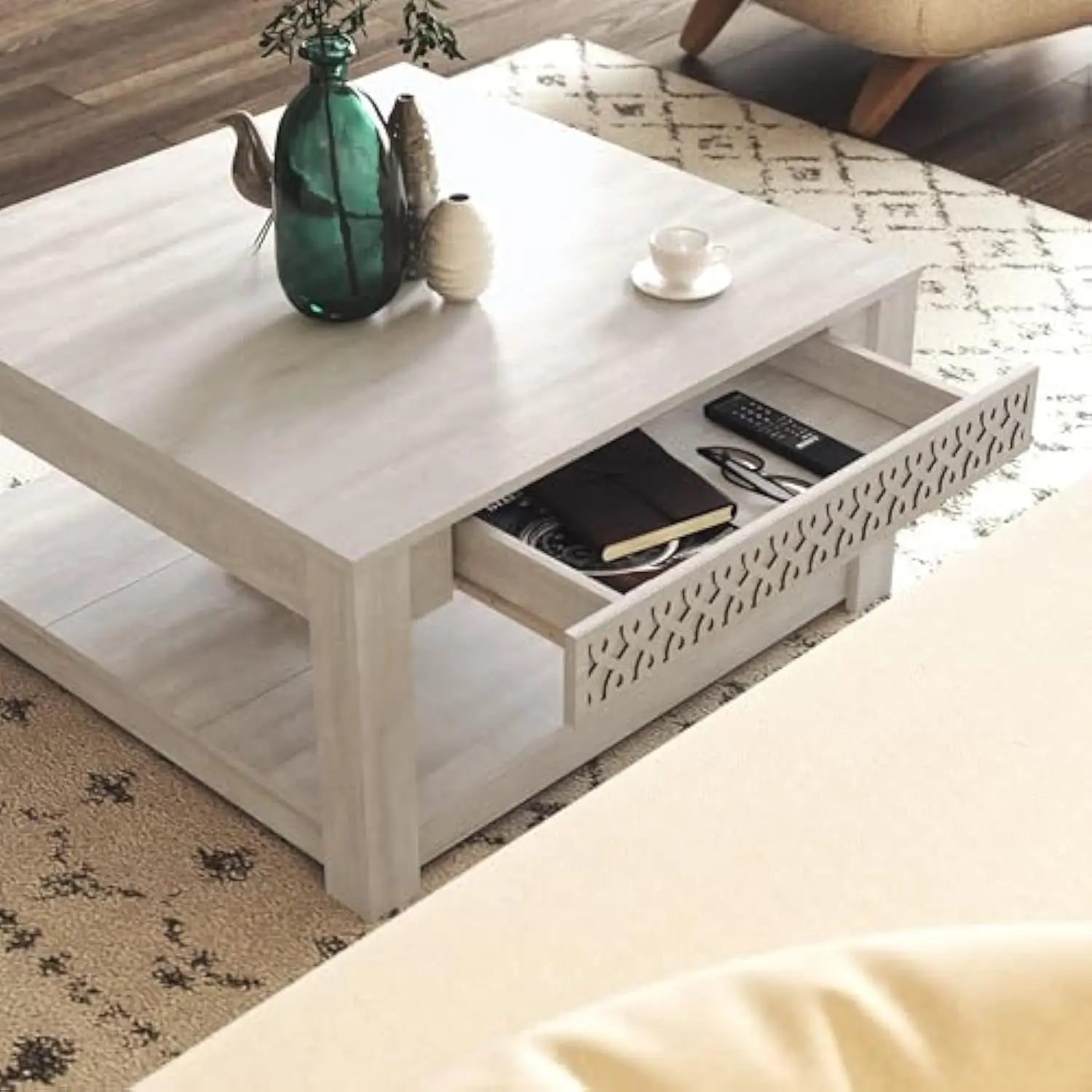
Practical Assessment: Your Hands-On Inspection Guide
Developing a systematic approach to furniture evaluation helps ensure nothing important gets overlooked. This methodical process incorporates all the elements we’ve discussed into a practical workflow.
Systematic Evaluation Approach
Initial Visual Assessment
– Observe overall proportions and design integrity
– Note stylistic elements that indicate period
– Check for appropriate symmetry or intentional asymmetryPhysical Testing
– Assess weight (quality pieces are typically substantial)
– Test stability on level surface
– Examine drawers for smooth operationJoint Examination
– Investigate corner joints, particularly in stress areas
– Look under and behind the piece for construction details
– Check how legs and structural elements connectMaterial Identification
– Determine primary and secondary woods
– Assess grain patterns and wood quality
– Look for appropriate material selection for different componentsHardware Inspection
– Examine age-appropriateness of visible hardware
– Check for consistent patina and wear
– Look for replacement components
Helpful Assessment Tools
Several simple tools can enhance your examination:
– Small flashlight for illuminating dark areas
– Magnifying glass for examining joints and wood grain
– Soft cloth for gentle cleaning during inspection
– Camera to document details for later reference
– Small mirror to view underneath or behind pieces
Remember to conduct examinations in good lighting and take time to inspect all aspects of the piece, including less visible areas that often reveal the most about construction methods.
The careful inspection of mid-century modern Danish coffee tables and other vintage pieces rewards the patient observer with insights into craftsmanship excellence.
Red Flags: Spotting Reproductions and Poor Craftsmanship
While identifying quality indicators helps recognize genuine vintage pieces, recognizing warning signs is equally important. Certain characteristics clearly signal reproduction furniture or inferior construction methods.
Warning Signs of Inferior Craftsmanship
Watch for these indicators of poor quality or reproduction:
– Excessive staples, particularly in structural joints
– Visible glue excess around joints
– Particleboard or MDF in pieces purported to be antique (these materials weren’t widely used until the 1970s)
– Uniform “distressing” that doesn’t follow natural wear patterns
– Perfect symmetry in supposedly hand-crafted elements
– Wood grain patterns that don’t flow naturally across components
Anachronistic Elements
Certain features couldn’t exist in genuine period pieces:
– Phillips-head screws in furniture claimed to be pre-1930s
– Particle board in “antique” furniture
– Modern adhesives or construction techniques in supposedly vintage pieces
– Hardware styles inconsistent with the furniture period
Reproduction Techniques
Some common reproduction styles to watch for:
– Artificially “aged” finishes with inconsistent wear
– Simulated tool marks that don’t match period techniques
– Machine-distressed edges that create too-uniform “wear”
– New wood artificially darkened to simulate age
Mid-Century Modern Solid Wood Coffee Tables, Mid-Century Modern Teak Coffee Tables
$879.95 Select options This product has multiple variants. The options may be chosen on the product pageMid-Century Modern Danish Coffee Tables, Mid-Century Modern Oval Coffee Tables, Mid-Century Modern Solid Wood Coffee Tables
$390.05 Select options This product has multiple variants. The options may be chosen on the product pageMid-Century Modern Glass Top Coffee Tables, Mid-Century Modern Vintage Coffee Tables, Mid-Century Modern Vintage Side & End Tables
$725.36 Select options This product has multiple variants. The options may be chosen on the product pageMid-Century Modern Oval Coffee Tables, Mid-Century Modern Solid Wood Coffee Tables
$679.56 Select options This product has multiple variants. The options may be chosen on the product pageMid-Century Modern Solid Wood Coffee Tables, Mid-Century Modern Walnut Coffee Tables
$501.53 Select options This product has multiple variants. The options may be chosen on the product pageMid-Century Modern Round Coffee Tables, Mid-Century Modern Solid Wood Coffee Tables
Price range: $522.31 through $559.78 Select options This product has multiple variants. The options may be chosen on the product page
Understanding these warning signs helps distinguish between quality reproductions (which may themselves have value) and deceptive pieces misrepresented as vintage. The difference often lies not in the fact of reproduction but in honesty about origin and construction.

Collecting With Confidence: Applying Your Craftsmanship Knowledge
As you develop your understanding of furniture craftsmanship, you’ll find yourself noticing details that previously escaped attention. This growing expertise transforms how you experience and evaluate vintage furniture.
The key indicators we’ve explored—quality joinery, superior materials, appropriate hardware, structural integrity, and authentic aging—work together to tell the complete story of a piece. With practice, you’ll develop an intuitive sense for authenticity that complements technical knowledge.
Continuing your education enhances appreciation and confidence:
– Museum furniture collections offer opportunities to study authenticated pieces
– Reference books with detailed photographs help train your eye
– Furniture exhibitions showcase exceptional examples of different periods
– Online collector communities provide venues for knowledge sharing
Beyond monetary considerations, understanding craftsmanship enriches the collecting experience by connecting you to design history and the skilled hands that created these enduring pieces. Each vintage item carries stories of both its creation and subsequent journey—stories revealed through construction details, wear patterns, and design choices.
This knowledge ultimately leads to more thoughtful collecting decisions and deeper appreciation for the design features of oval-shaped tables and other distinctive furniture forms that have stood the test of time.
Is Professional Authentication Worth the Investment?
For certain furniture pieces, professional authentication provides valuable verification beyond what individual assessment can determine. This service becomes particularly relevant when:
– The piece represents a significant financial investment
– It’s attributed to a notable designer or manufacturer
– Insurance documentation requires professional assessment
– You’re considering resale to serious collectors
Professional authenticators bring specialized knowledge about specific makers, periods, and regional variations. They examine elements that casual observers might miss, including:
– Construction techniques unique to certain workshops
– Material sourcing patterns of specific manufacturers
– Finishing formulations characteristic of different makers
– Documentation and provenance verification
Authentication services generally charge based on the value and complexity of the item being examined. While costs can range from moderate to substantial, this investment often pays dividends through increased confidence and potential value confirmation for significant pieces.
When choosing authentication services, look for established credentials, museum experience, or specific expertise in the furniture period or maker you’re researching.
Can You Judge Quality from Online Listings Alone?
Evaluating furniture remotely presents unique challenges but isn’t impossible with the right approach. When examining online listings:
Ask for specific photos that reveal construction details:
– Drawer interiors showing joinery
– Undersides showing structural elements
– Close-ups of hardware and finishes
– Images of any maker’s marks or labels
Request detailed information about:
– Wood types used throughout the piece
– Construction methods for joints and structural elements
– Weight of the piece (heavier generally indicates solid wood)
– Any repairs or restoration work performed
Watch for vague descriptions that avoid construction details or use generic terms like “wood” without specifying the type. Quality sellers typically understand construction details and willingly provide specific information.
For significant purchases, consider a video call examination where the seller can show specific elements in real-time based on your requests. This interactive approach provides much more information than static photos alone.
While remote assessment can’t replace hands-on examination, developing your knowledge of craftsmanship indicators helps you ask the right questions and recognize quality even through digital means.

